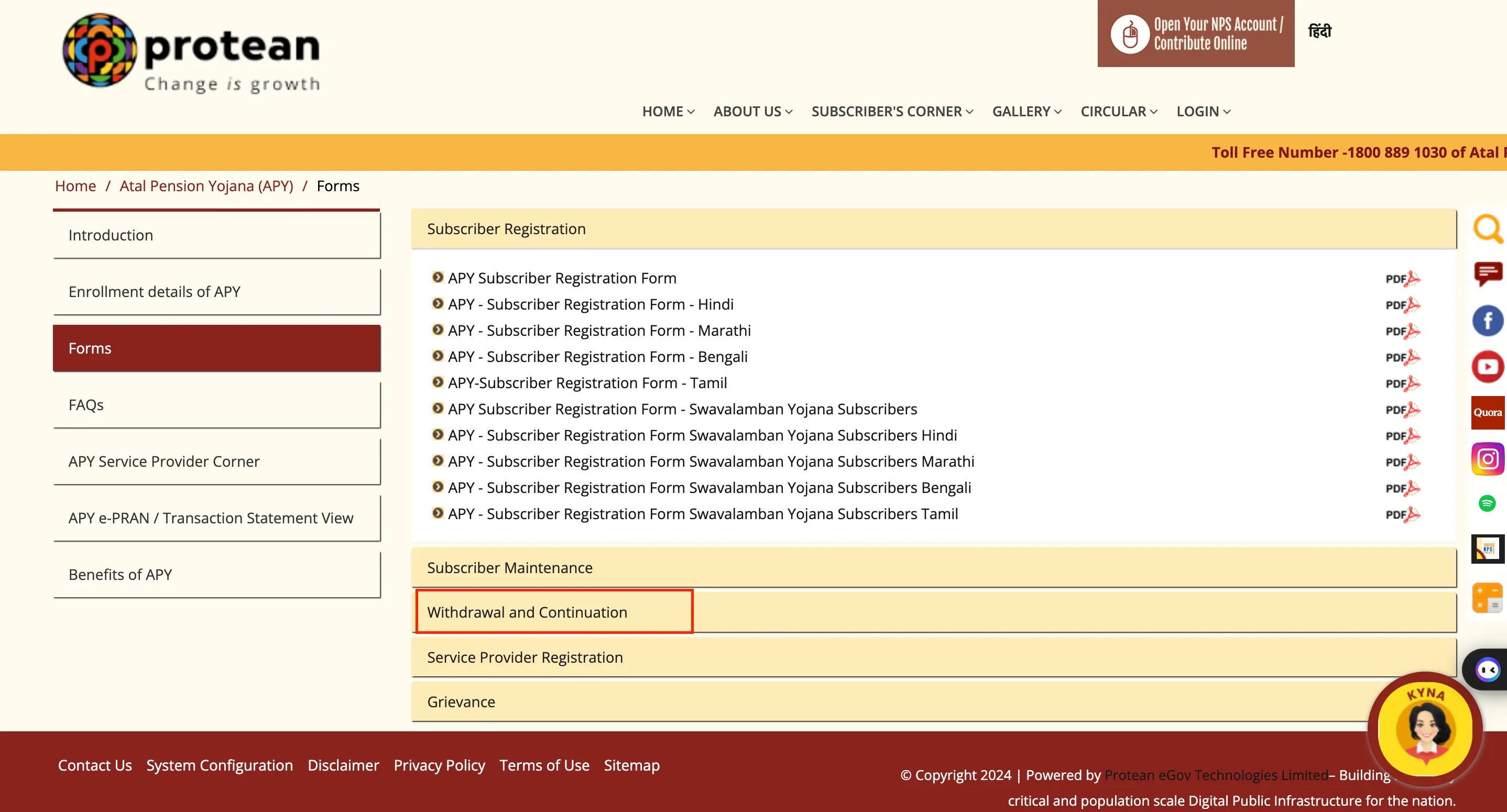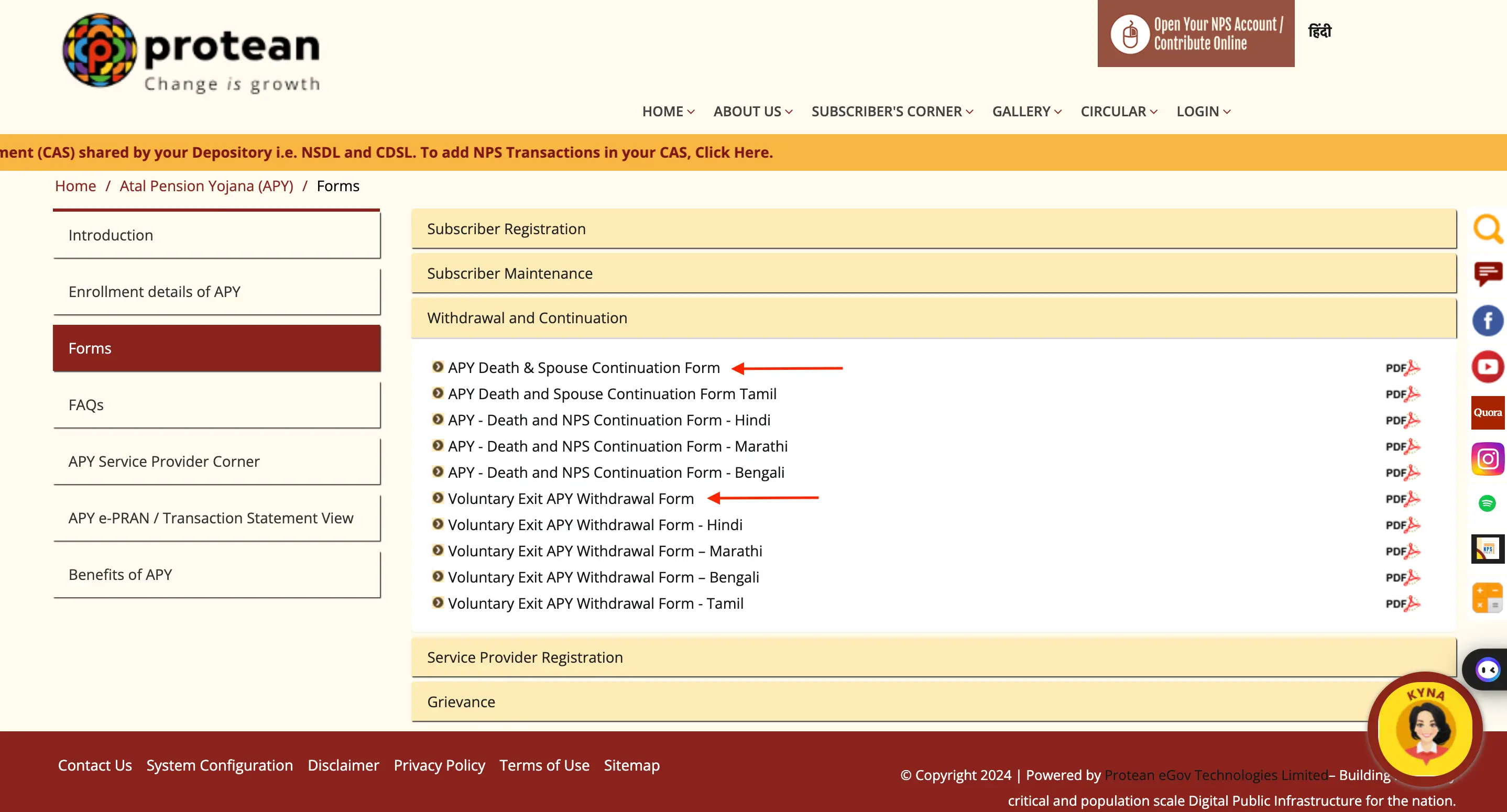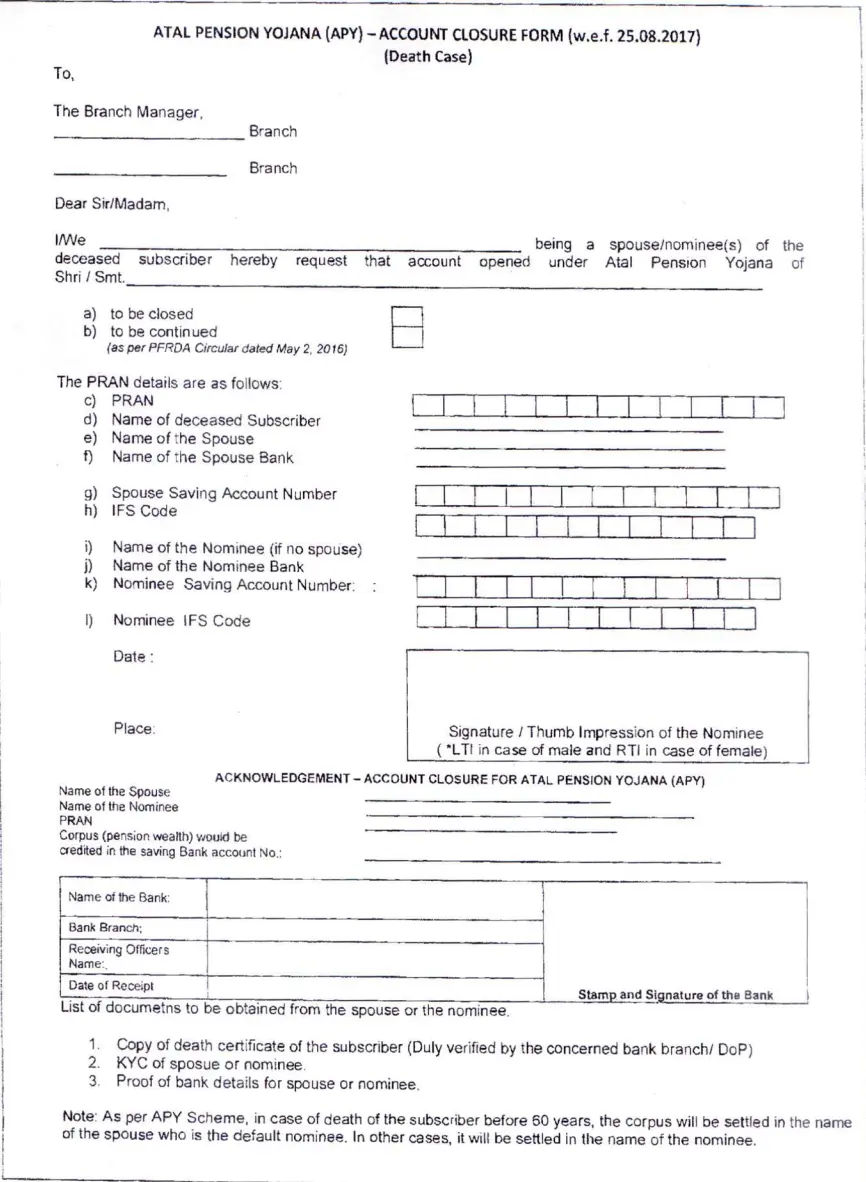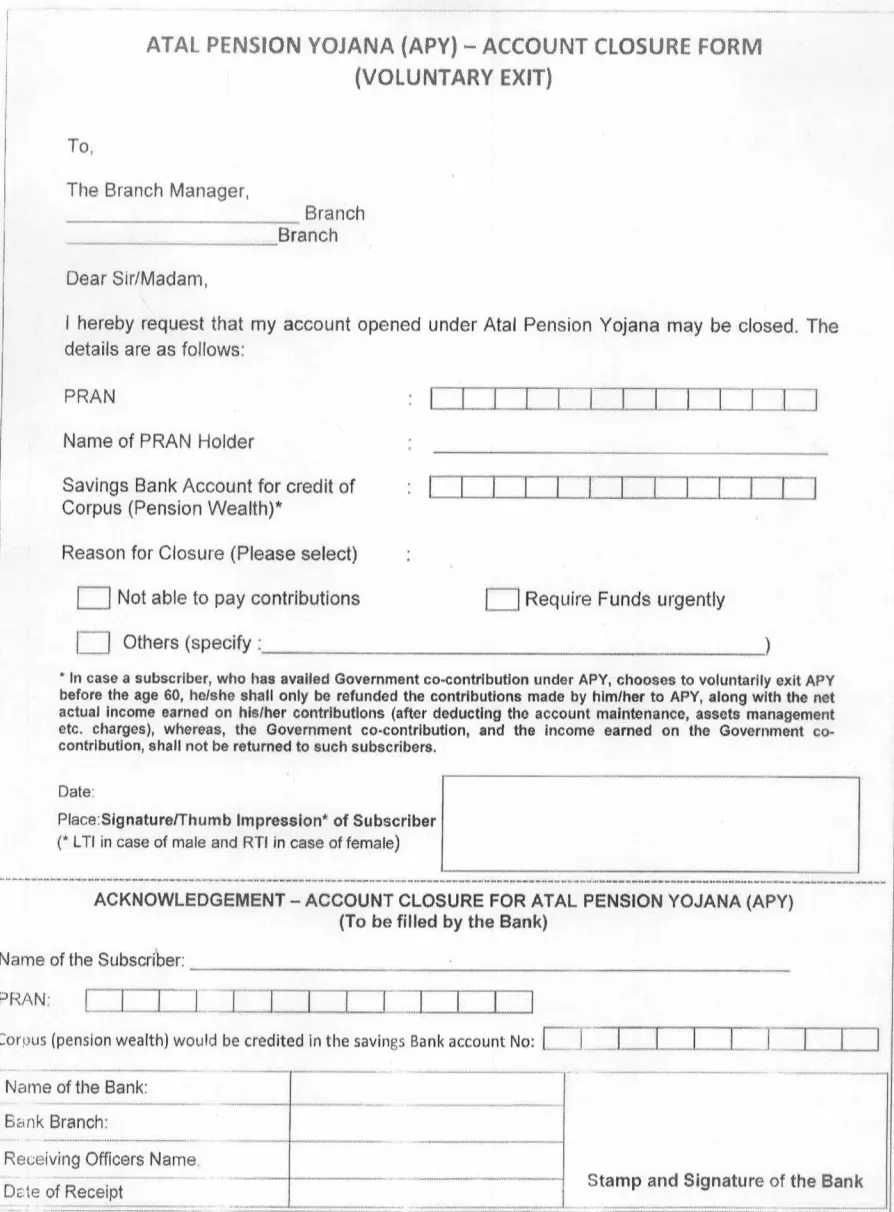The Atal Pension Yojana (APY) offers retirement income security for Indian citizens, especially those in the unorganized sector. You contribute a fixed amount monthly, and the government co-contributes up to a limit depending on your enrollment age.
The Atal Pension Yojana (APY) exit policy determines what happens to your contributions and accumulated amount depending on why you need to exit the scheme. The ideal exit is at 60, when you can start receiving your chosen monthly pension.
Table of Content
Steps to Exit Atal Pension Yojana Account
The APY exit policy allows subscribers to receive their chosen monthly pension upon turning 60 by requesting it from their APY bank. It also enables earlier exits and, in case of the subscriber's death, it gives the spouse the choice to continue the pension or withdraw the accumulated corpus.
APY scheme exits can be processed both online and offline.
Steps for APY Exit Online
To close the Atal Pension Yojana online, follow these steps:
Step 1: Go to the official NPS CRA website.
Step 2: Choose ‘NPS Lite/APY’ and then select ‘Atal Pension Yojana’.

Step 3: Click on "Forms" and then select the "Withdrawal and Continuation" section.

Step 4: Download either the "APY Death & Spouse Continuation" form or the "Voluntary Exit APY Withdrawal Form" based on your requirements.

Step 5: Fill out the form with necessary details such as PRAN, name, etc. If opting for voluntary exit, provide the appropriate reasons such as inability to pay contributions, urgent need for funds, or specify other reasons.
Step 6: Submit the form to the bank officials along with the required supporting documents. Make sure to keep the necessary documents ready as per the Atal Pension Yojana closure process.
Steps for APY Exit Offline
To close your Atal Pension Yojana account offline, you can follow these steps:
- Step 1: Visit the bank where you have your Atal Pension Yojana account.
- Step 2: Complete the Atal Pension Yojana cancellation form with the required details.
- Step 3: Submit the signed form to the bank and wait for verification.
- Step 4: Once the process is complete, your funds and interest will be transferred to your linked bank account. You will also receive a notification on your registered mobile number from the bank. Make sure to collect the stamped acknowledgment receipt from the bank as well.
Are you looking for a personal loan?
Documents Required For Closing APY Account
If the beneficiary passes away before the age of 60, the spouse is required to provide the following documents when applying for early withdrawal:
- Original death certificate of the beneficiary.
- Bank details and KYC of the spouse or nominee.
- Proof of relationship certificate, which can be a legal heir certificate or a family member's certificate issued by the Executive Magistrate. This is applicable only if someone other than the spouse or nominee is submitting a closure request.
Atal Pension Yojana Closure Form Download
Here are the steps to download the exit/ closure form for the Atal Pension Yojana scheme:
- Step 1: Visit the NPS CRA official website.
- Step 2: Select the 'NPS Lite/APY' option and then choose 'Atal Pension Yojana'. Go to the "Forms" section and pick the "Withdrawal and Continuation" category.
- Step 3: Download either the "APY Death & Spouse Continuation" form or the "Voluntary Exit APY Withdrawal Form" according to your requirements.
Sample of Closure Form for “APY Death & Spouse Continuation”

Sample of Closure Form for “Voluntary Exit APY Withdrawal Form”

Don't know your credit score? You can find out for free!
Atal Pension Yojana Withdrawal Process
The Atal Pension Yojana (APY) is a government-sponsored pension scheme that provides a guaranteed minimum monthly pension to its subscribers upon retirement. The scheme allows for withdrawal under certain circumstances, which are detailed as follows:
1. When the subscriber reaches 60 years of age:
- The subscriber needs to submit a withdrawal request to receive a higher monthly pension or a guaranteed minimum monthly pension.
- If the returns on the subscriber's contributions are higher, the subscriber will receive a higher monthly pension.
- After the subscriber's demise, the spouse will receive an equal monthly pension.
- If there are other beneficiaries (such as children), they will receive an annuity amount after the demise of both the subscriber and the spouse.
2. When the subscriber dies after reaching 60 years of age:
- The spouse will receive the pension amount that the subscriber was receiving.
- Other beneficiaries will only receive the pension amount after the demise of both the subscriber and the spouse.
3. When a subscriber dies before reaching 60 years of age:
- In this case, the spouse can continue the account.
- The account will be transferred to the spouse's name, and they will need to make contributions until the subscriber has turned 60 years old.
- The pension amount for the spouse will be the same as it would have been for the subscriber.
- If the spouse chooses to discontinue the account, the entire accumulated fund will be returned to the spouse or the designated beneficiary.
The key points to remember:
- The subscriber can withdraw and receive a higher or guaranteed minimum pension upon reaching 60 years of age.
- After the subscriber's demise, the spouse and other beneficiaries are entitled to receive the pension amount.
- If the subscriber dies before 60 years, the spouse can continue the account until the subscriber has turned 60, or they can choose to discontinue and receive the accumulated funds.
Illnesses Eligible for APY Withdrawal
The APY scheme offers some flexibility for those facing critical health situations. You can withdraw your accumulated contributions, including the government co-contribution if you're diagnosed with a qualifying illness. This can provide much-needed financial support during a difficult time.
List of Qualifying Illnesses
The National Pension System Regulations (2015) define specific illnesses that qualify for APY withdrawal with government co-contribution. This list includes.
- Kidney failure
- Major organ transplant
- Heart-related conditions (coronary artery bypass, valve surgery, etc.)
- Stroke
- Myocardial infarction (heart attack)
- Coma
- Paralysis
- Complete blindness
- Life-threatening accidents
- Multiple sclerosis
- Cancer
- Primary pulmonary arterial hypertension
You can also check other topics for the Atal Pension Yojana
Do you need an instant loan?
Frequently Asked Questions
Yes, premature exit from APY is allowed under certain conditions.
You can exit APY by submitting a withdrawal form to your bank or the APY service provider.
If you exit APY before the retirement age of 60, you will receive only the contributed amount without any interest or government co-contribution.
You can exit APY before 60 if you have made contributions for at least 10 years or in case of permanent disability or death.
You can withdraw the contributed amount by submitting the withdrawal form to your bank or APY service provider.
Yes, premature exit from APY is allowed under certain conditions like permanent disability or death.
The main conditions for exiting APY before 60 are: contributing for at least 10 years, permanent disability, or death.
Display of trademarks, trade names, logos, and other subject matters of Intellectual Property displayed on this website belongs to their respective intellectual property owners & is not owned by Bvalue Services Pvt. Ltd. Display of such Intellectual Property and related product information does not imply Bvalue Services Pvt. Ltd company’s partnership with the owner of the Intellectual Property or proprietor of such products.
Please read the Terms & Conditions carefully as deemed & proceed at your own discretion.






 Rated 4.5 on Google Play
Rated 4.5 on Google Play 10M+ App Installs
10M+ App Installs 25M+ Applicants till date & growing
25M+ Applicants till date & growing 150K+ Daily Active Users
150K+ Daily Active Users